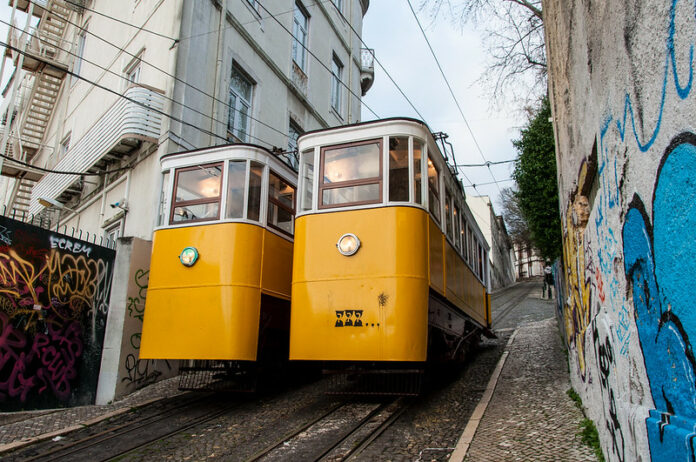September 3, 2025 began like any other late-summer day in Lisbon. On Rua da Glória, tourists lined up as they do every day to ride one of the city’s most beloved landmarks known as the Glória funicular. But at around 6:15 pm Lisbon time, a cable snapped and suddenly the funicular careened the down the hill and derailed, crashing into a building and killing 17 people from Portugal and around the world and injuring more than 20 more in what is now already considered one of Portugal’s deadliest transport accidents.
Lisbon has already declared a day of national mourning for September 4. Here is what we know so far about this terrible tragedy that is already under investigation.
A Historic Lisbon Icon
The Glória funicular, which opened in 1885, is classified as a national monument and connects the city’s downtown Baixa district with Bairro Alto, climbing 265 meters up a steep slope parallel to Avenida da Liberdade and Rossio station.
Capable of carrying more than 40 passengers, the funicular is both a daily commuter link and a popular tourist attraction. It carries over three million riders a year, and its operation relies on two cars running in opposite directions, counterbalanced by a cable system powered by electric motors.
For 140 years, it was seen as safe, charming, and reliable – until Wednesday evening, September 3, 2025.
The Moment of Disaster
At 6:15 p.m., with the sun still high and queues of visitors waiting their turn, tragedy struck. According to early reports, a haulage cable suddenly snapped as the uphill carriage was descending. The tram lost control, gathered speed, and careened backwards, derailing from the tracks and crashing into a building.
Another carriage waiting at the bottom dropped suddenly by two meters and passengers inside suffered minor injuries. As of September 4, 2025, seventeen people have been killed, five remain in serious condition, and 21 in total were reported injured. Emergency responders worked through the evening to pull survivors from the crumpled yellow wreckage.
Victims from around the World
The disaster has affected people from around the world, with officials confirming that multiple nationalities are among the dead and injured, including visitors from Germany, Spain, France, Italy, Switzerland, Cabo Verde, Morocco, Canada, and South Korea.
One particularly harrowing story has emerged of a three-year-old German boy pulled alive from the wreckage. His father died in the crash, while his pregnant mother was hospitalized with injuries and later transferred to a maternity clinic.
Among the Portuguese dead was André Marques, the 40-year-old brakeman on the carriage and father of two. He had worked for Carris, the city’s public transport company, for 15 years. Carris described him as a dedicated professional who was always willing to contribute to the greater good.
Eyewitnesses spoke of terror and confusion as the runaway carriage hurtled down the slope. One woman reported that the funicular had no brakes, hit a building with brutal force, and collapsed like a cardboard box.
Another described hearing the first tram jolt against a barrier at the bottom of the hill and then watched in horror as the second tram sped uncontrollably, having just enough time to run out of the way.
Investigations Underway
While the official cause has yet to be determined, local media have reported that the cable system may have failed. Forensic teams and transport safety officials worked overnight to collect evidence from the wreckage. In fact, on 7 May 2018, one of the Glória funicular cars derailed due to a lack of maintenance of its wheels, but no one was injured. The maintenance record will need to be given a hard look to determine and ensure that it was up to date.
Portugal’s National Institute of Legal Medicine has been tasked with identifying victims, while the National Transport Safety Authority, the Lisbon police, and Carris have all launched investigations.
The city council has suspended operations of Lisbon’s other funiculars – Bica, Lavra, and Graça – pending urgent safety inspections.
Mourning and Reactions
President Marcelo Rebelo de Sousa declared Thursday a national day of mourning. “The President of the Republic deeply regrets the accident, particularly the fatalities and serious injuries.
Lisbon’s mayor, Carlos Moedas, who visited the site, called it “a tragedy that has never happened before in our city,” adding, “Lisbon is in mourning. Now is the time for action and help.”
Residents of Bairro Alto expressed both sorrow and frustration. The head of the neighborhood residents’ association blamed excessive tourism for overloading the historic system, further claiming that it was used so much in recent years that the locals lost the ability to use it as public transport, and it became primarily a tourist attraction.
What Comes Next
As Lisbon grieves, attention now shifts to accountability. How could a national monument carrying millions of passengers a year fail so catastrophically? Was the cable system inadequately maintained? Did braking systems malfunction?
The coming days weeks must bring answers. For now, Portugal is focused on honoring the dead, the survivors, and its shaken capital.
Seventeen lives lost on a tram that was supposed to symbolize Lisbon’s charm and history. Now, the Glória funicular has become the site of national tragedy.


